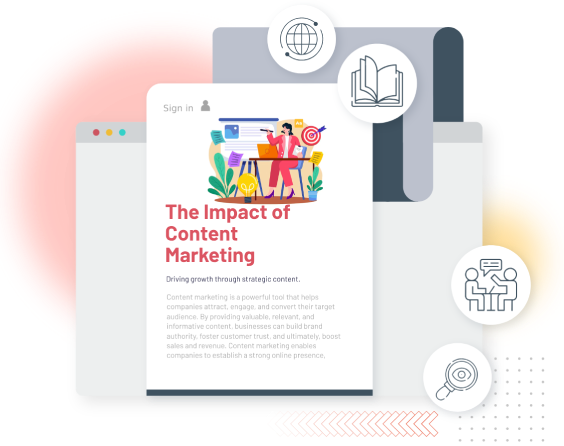

By 2025, the digital content universe will be generating over 463 exabytes of data every day. That's 463 billion gigabytes—more than double the data we produced in 2020. In a world overflowing with content, how do you make sure your voice stands out?
The answer lies in building a content strategy that isn't just relevant for today, but flexible enough to adapt to the rapid shifts in technology, consumer preferences, and digital content platforms. As the digital content landscape becomes more competitive and dynamic, creating a content strategy that stands the test of time is no longer a luxury—it's a necessity.
This blog will guide you through the process of crafting a content strategy for 2025 and beyond along with the best practices for long-term content marketing. Let’s get started!
Before you get into the nuts and bolts of your content plan, take a step back and define your goals. You wouldn’t start a road trip without knowing your destination, right? The same goes for your content strategy.
What you should do:
Example:
If you’re aiming for a 30% increase in website traffic, track it monthly. If certain types of digital content (like videos or blog posts) are driving the most visitors, focus more on those.
No content strategy can succeed without understanding the people you’re talking to. Think of your audience as your best friends. You know what excites them, what their struggles are, and what makes them tick. Here’s how you can do it.
The first step in understanding your audience is dividing them into specific segments based on common characteristics. Think of it as creating personas. These segments can be based on:
Steps To Group Audience
Example:
If you run an e-commerce store, your audience could be segmented into groups like “fashion-forward millennials,” “working professionals,” or “budget-conscious shoppers.” Each group has different needs and interests, so your content should speak directly to those specific needs. For instance, “fashion-forward millennials” might love content about the latest fashion trends, while “budget-conscious shoppers” may be more interested in discount offers or affordable styling tips.
Once you’ve segmented your audience, it’s time to create content that speaks directly to each segment. Customize your messaging and content types based on the preferences and behaviors of each group.
How to do it:
Example:
Let’s say you’ve segmented your audience into “health-conscious individuals” and “busy professionals.” For the health-conscious group, you could create content around nutrition tips, workout routines, and wellness recipes. On the other hand, the busy professionals segment might appreciate content about quick and easy meal prep, time-saving health hacks, or stress management techniques.
Once you start segmenting and creating targeted content, the next step is to monitor and collect data to figure out what’s resonating most with each group. This isn’t a one-time thing—it’s an ongoing process. The more you know about your audience, the more precise you can be with your content in the future.
How to do it:
Example:
If your analysis shows that “how-to guides” are performing well with your audience, that’s a sign you should create more instructional content—maybe even delve deeper into specific subtopics or create a series of guides that build on each other.
|
Bonus Tip: |
To succeed in the long term, your content strategy must be both scalable and sustainable. The goal is to create a content plan that evolves with changes in technology, audience behavior, and industry trends.
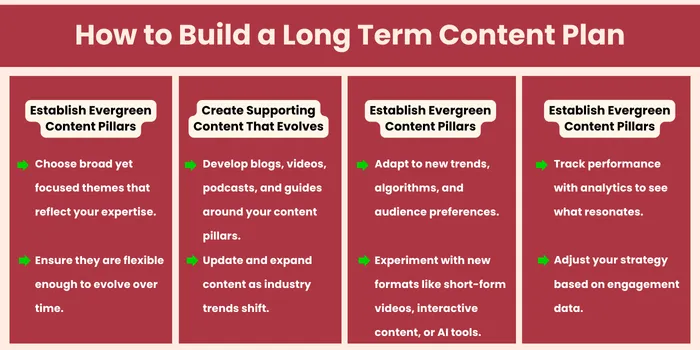
Why This Approach Works
Embracing AI and automation is key to making your content strategy future-ready because it allows you to stay efficient, adapt quickly, and scale your efforts as the digital landscape evolves. Here’s how it fits into a future-proof content plan:
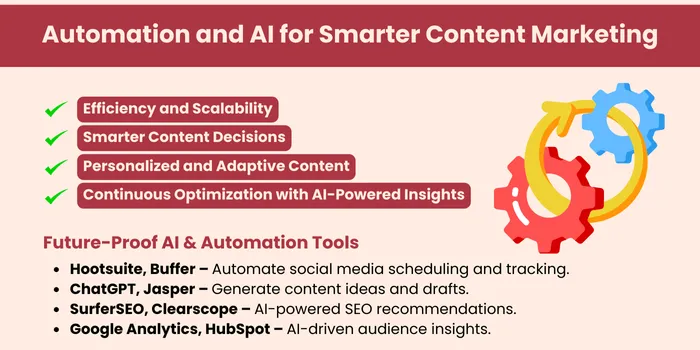
A content strategy that relies solely on manual effort will eventually struggle to keep up with changing audience demands and the fast pace of content consumption. AI tools help you automate repetitive tasks like scheduling, keyword research, and performance tracking, freeing up time for high-value creative work.
Future-Proof Benefit: You can consistently produce and distribute content at scale without increasing workload or costs.
AI-driven tools can analyze massive amounts of data to identify trends, audience preferences, and content gaps. Instead of guessing what works, AI helps you predict what will engage your audience, ensuring that your strategy stays relevant.
Future-Proof Benefit: You can adapt your content to emerging trends before they become mainstream, keeping you ahead of competitors.
With AI, content can be dynamically personalized based on user behavior, demographics, or past interactions. This means your audience gets more relevant content, increasing engagement and brand loyalty.
Future-Proof Benefit: As personalization becomes the standard, your strategy will already be optimized to meet audience expectations.
Automation tools don’t just distribute content—they provide real-time feedback on what’s working and what’s not. AI can suggest changes, refine headlines, or even recommend the best posting times based on audience activity.
Future-Proof Benefit: Your content strategy continuously improves, ensuring long-term success instead of relying on outdated tactics.
Now that you’ve got your content machine running, it’s time to measure success and continuously improve. After all, content marketing isn’t a “set it and forget it” process. You’ll want to constantly adjust to ensure your content is working.
What you should do:
The world of digital content is constantly evolving, and staying ahead of the curve can set you apart from the competition. What trends should you watch for in 2025?
By now, you should have a clear idea of how to build a content strategy that not only works today but is also scalable for the future. Remember, a successful content strategy requires continuous evolution. Be flexible, stay informed, and always be ready to adjust to new trends.
At LexiConn, we craft content strategies that adapt, evolve, and stay relevant. Our approach ensures your content remains engaging, SEO-friendly, and aligned with industry trends. Here’s how we future-proof your content strategy:
🔹 SEO & Trend Analysis – We track emerging keywords, search trends, and algorithm updates to keep your content visible and competitive.
🔹 Content Performance Review – We assess engagement metrics, audience behavior, and content effectiveness to refine your approach.
🔹 AI & Automation Integration – We leverage AI-driven tools to enhance content creation, optimize publishing schedules, and personalize content for your audience.
🔹 Evergreen & Scalable Content Planning – We help you develop strong content pillars that stay relevant while allowing for updates and expansion.
🔹 Competitor Insights & Market Benchmarking – We analyze what’s working in your industry, identifying opportunities for innovation and differentiation.
If your content isn’t driving consistent engagement or conversions, it’s time to rethink your strategy. Let LexiConn help you stay ahead, stay relevant, and maximize your content’s impact.
Book a free content strategy consultation today and set your brand up for long-term success!
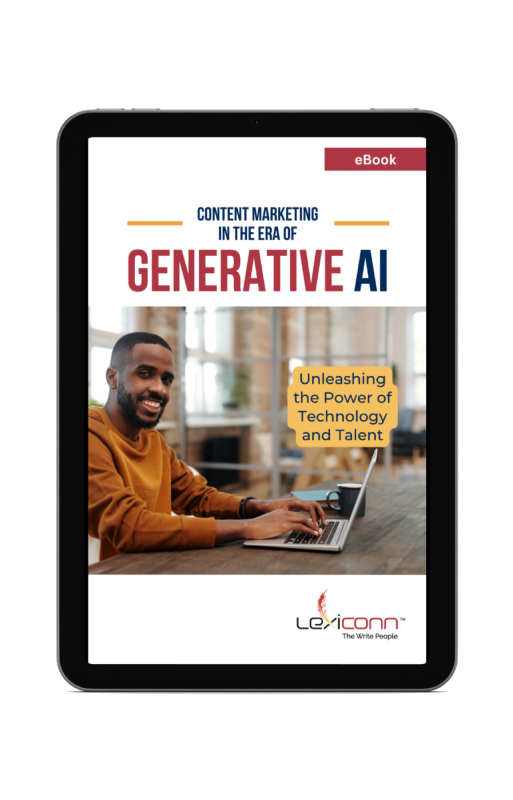
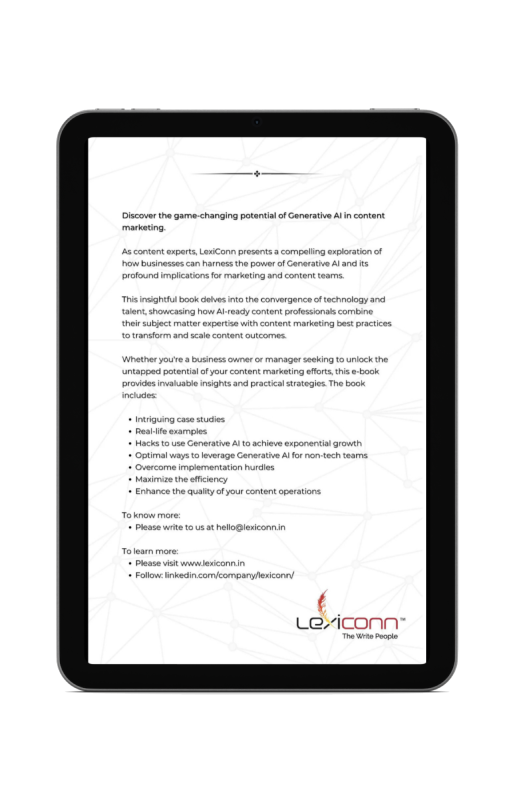
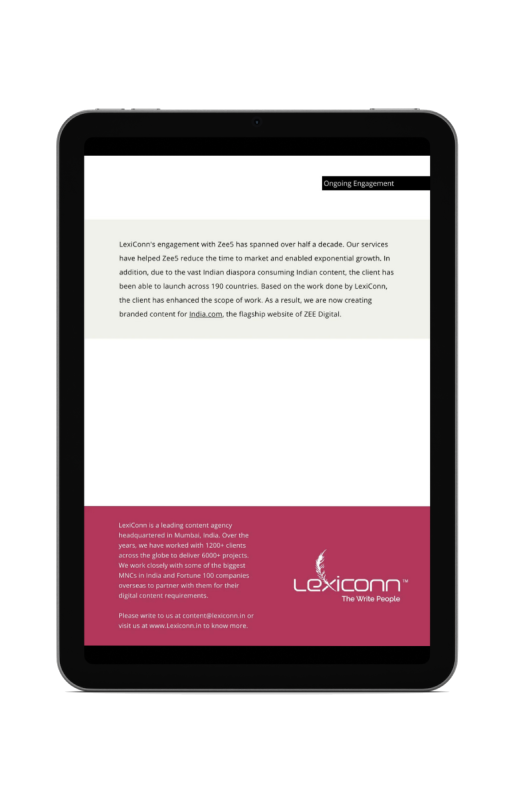
I have read and accept the Privacy Policy
Read More